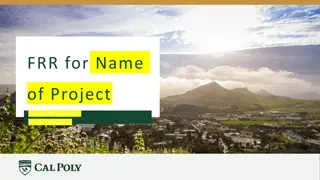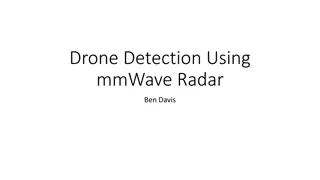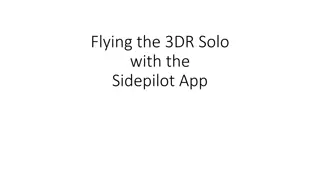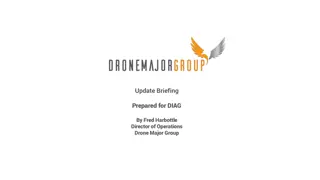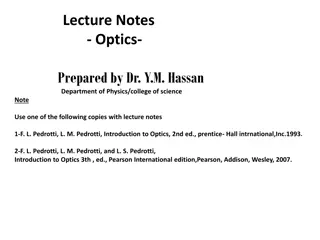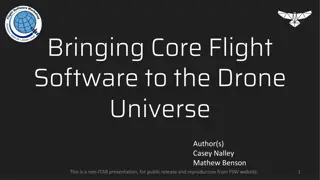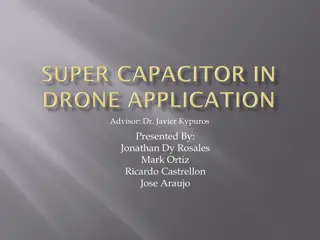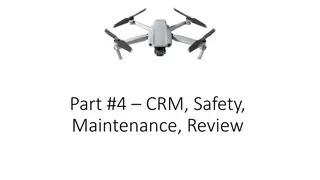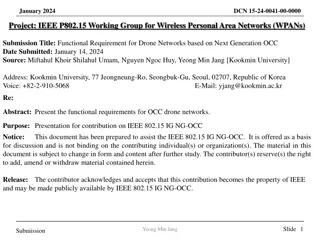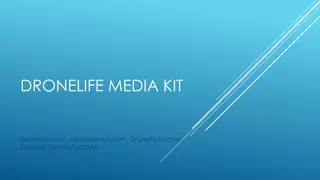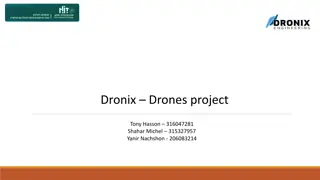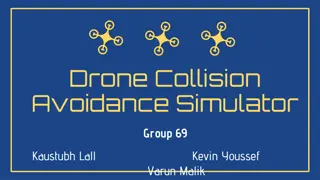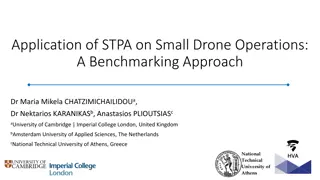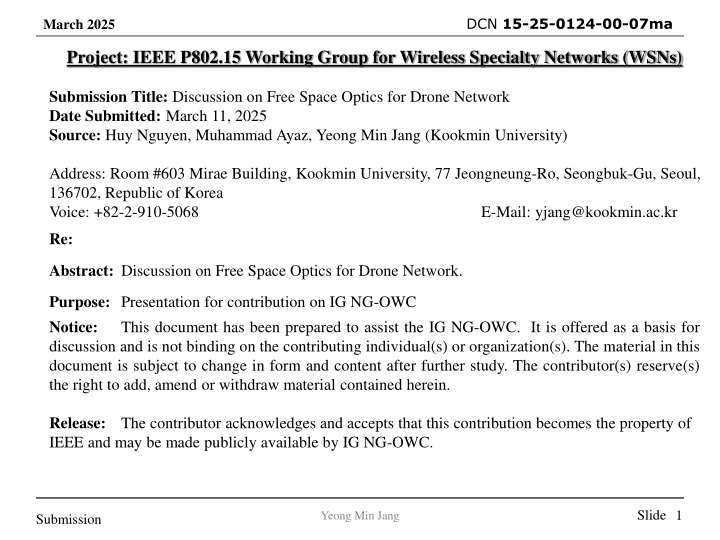
Enhancing Drone Networks with Free Space Optics Technology
"Explore the potential of Free Space Optics (FSO) technology integrated with drones for high-speed, secure, and flexible communication networks. FSO offers advantages like high data rates, easy installation, and compatibility with various access technologies, revolutionizing aerospace and telecommunication systems."
Download Presentation

Please find below an Image/Link to download the presentation.
The content on the website is provided AS IS for your information and personal use only. It may not be sold, licensed, or shared on other websites without obtaining consent from the author. If you encounter any issues during the download, it is possible that the publisher has removed the file from their server.
You are allowed to download the files provided on this website for personal or commercial use, subject to the condition that they are used lawfully. All files are the property of their respective owners.
The content on the website is provided AS IS for your information and personal use only. It may not be sold, licensed, or shared on other websites without obtaining consent from the author.
E N D
Presentation Transcript
DCN 15-25-0124-00-07ma March 2025 Project: IEEE P802.15 Working Group for Wireless Specialty Networks (WSNs) Submission Title: Discussion on Free Space Optics for Drone Network Date Submitted: March 11, 2025 Source: Huy Nguyen, Muhammad Ayaz, Yeong Min Jang (Kookmin University) Address: Room #603 Mirae Building, Kookmin University, 77 Jeongneung-Ro, Seongbuk-Gu, Seoul, 136702, Republic of Korea Voice: +82-2-910-5068 E-Mail: yjang@kookmin.ac.kr Re: Abstract: Discussion on Free Space Optics for Drone Network. Purpose: Presentation for contribution on IG NG-OWC Notice: This document has been prepared to assist the IG NG-OWC. It is offered as a basis for discussion and is not binding on the contributing individual(s) or organization(s). The material in this document is subject to change in form and content after further study. The contributor(s) reserve(s) the right to add, amend or withdraw material contained herein. Release: The contributor acknowledges and accepts that this contribution becomes the property of IEEE and may be made publicly available by IG NG-OWC. Slide 1 Yeong Min Jang Submission
DCN 15-25-0124-00-07ma March 2025 Discussion on Free Space Optics for Drone Network March 11, 2025 Slide 2 Yeong Min Jang Submission
DCN 15-25-0124-00-07ma March 2025 Contents Overview of FSO Advantages of FSO FSO limitations UAV-FSO communication deployment scenario FSO-based drone-assisted mobile network architecture Conclusion References Slide 3 Yeong Min Jang Submission
DCN 15-25-0124-00-07ma March 2025 Overview of FSO Free Space Optics (FSO), a wireless optical communication technology, presents a promising solution for high-speed, secure, and flexible communication networks. Free Space Optics (FSO) presents a promising approach for enhancing drone network capabilities, particularly in scenarios demanding high bandwidth and secure communication. Integrated with Unmanned Aerial Vehicles (UAVs), or drones, FSO can revolutionize various applications, from emergency response and disaster relief to precision agriculture and remote sensing. FSO and UAVs provide transformative possibilities for secure, high-speed, and mobile communication networks, paving the way for next-gen aerospace and telecommunication systems Slide 4 Yeong Min Jang Submission
DCN 15-25-0124-00-07ma March 2025 Overview of FSO Advantages of FSO High rates No frequency license required Fast and easy installation Distance up to kms Compatible with other access technologies Cost effective, movable asset Near-zero latency over all distances Transparent to networks or protocols. Internal and external mounting Slide 5 Yeong Min Jang Submission
DCN 15-25-0124-00-07ma March 2025 Overview of FSO FSO limitations Spreading loss is higher and there is atmospheric loss due to water and carbon dioxide molecules. Power consumption is higher. It is easy to intercept due to its propagation medium and hence it is less secure than OFC. Transmitter and receiver should be in LOS (Line of Sight) to each other for its operation. The FSO transmitted signal gets blocked due to trees, animals, buildings and other atmospheric conditions. Birds and scintillation cause beam interruptions. Hence availability of FSO link depends on weather. Slide 6 Yeong Min Jang Submission
DCN 15-25-0124-00-07ma March 2025 UAV-FSO communication deployment scenario. UAV-FSO networks are deployed rapidly in disaster zones (e.g., earthquakes, floods) where terrestrial infrastructure is damaged. Drones establish temporary FSO links to relay critical data (e.g., HD video, sensor data) between rescue teams and command centers. Disaster Response and Emergency Communications UAV-FSO systems provide secure, high-bandwidth links for military surveillance, Military and Surveillance Applications UAV swarms or high-altitude platforms (HAPs) use FSO to establish links with satellites or other airborne nodes, enabling space-air-ground integrated networks (SAGIN). Inter-Satellite and Airborne Networks UAV-FSO networks collect and transmit environmental data (e.g., air quality, crop health) from remote areas. Environmental Monitoring and Precision Agriculture Slide 7 Yeong Min Jang Submission
DCN 15-25-0124-00-07ma March 2025 UAV-FSO communication deployment scenario. Figure.1.Relay-Assisted FSO Systems [2] Slide 8 Yeong Min Jang Submission
DCN 15-25-0124-00-07ma March 2025 FSO-based drone-assisted mobile network architecture. In order to quickly recover communications in disaster struck areas and achieve low communications delay between MUs and working MBSs Free space optics (FSO) based drone assisted mobile access network architecture Figure.2. FSO-based drone-assisted mobile network architecture [4] Slide 9 Yeong Min Jang Submission
DCN 15-25-0124-00-07ma March 2025 Conclusion Free Space Optics (FSO) and Unmanned Aerial Vehicles (UAVs) represents a cutting- edge synergy between high-speed optical communication and aerial platforms. FSO uses laser beams to transmit data through free space, offering ultra-fast speeds. Advances in AI, adaptive optics, and hybrid systems will reinforce reliability, while innovations like quantum key distribution (QKD) could further enhance security. Challenges like atmospheric effects and alignment persist, advances in hybrid systems, adaptive optics, and AI-driven control are paving the way for scalable deployments. Slide10 Yeong Min Jang Submission
DCN 15-25-0124-00-07ma March 2025 References [1] Nallagonda, V. R., & Krishnan, P. (2021). Performance analysis of FSO based inter-UAV communication systems. Optical and Quantum Electronics, 53(4). https://doi.org/10.1007/s11082-021-02843-w [2] Fawaz, W., Abou-Rjeily, C., & Assi, C. (2018). UAV-Aided cooperation for FSO communication systems. IEEE Communications Magazine, 56(1), 70 75. https://doi.org/10.1109/mcom.2017.1700320 [3] Nzekwu, N. J., Fernandes, M. A., Fernandes, G. M., Monteiro, P. P., & Guiomar, F. P. (2024). A comprehensive review of UAV- Assisted FSO relay systems. Photonics, 11(3), 274. https://doi.org/10.3390/photonics11030274 [4] Wu, D., Sun, X., & Ansari, N. (2019). An FSO-Based drone assisted mobile access network for emergency communications. IEEE Transactions on Network Science and Engineering, 7(3), 1597 1606. https://doi.org/10.1109/tnse.2019.2942266 [5] Yu, L., Sun, X., Shao, S., Chen, Y., & Albelaihi, R. (2023). Backhaul-Aware Drone Base Station Placement and Resource Management for FSO-Based Drone-Assisted Mobile Networks. IEEE Transactions on Network Science and Engineering, 10(3), 1659 1668. https://doi.org/10.1109/tnse.2022.3233004 Slide 11 Yeong Min Jang Submission


